Sunspot 1890 produced powerful X3.3 and three M-class solar flares
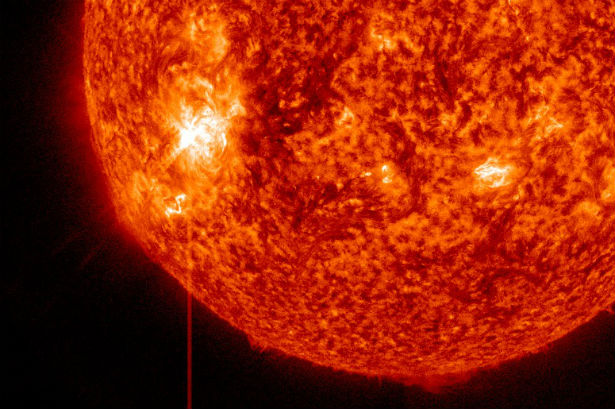
New active region 1890 produced yet another strong impulsive flare. Powerful X3.3 solar flare erupted at 22:12 UTC on November 5, 2013. This sunspot group already produced 2 M-class and dozens of C-class solar flares in the past two days.
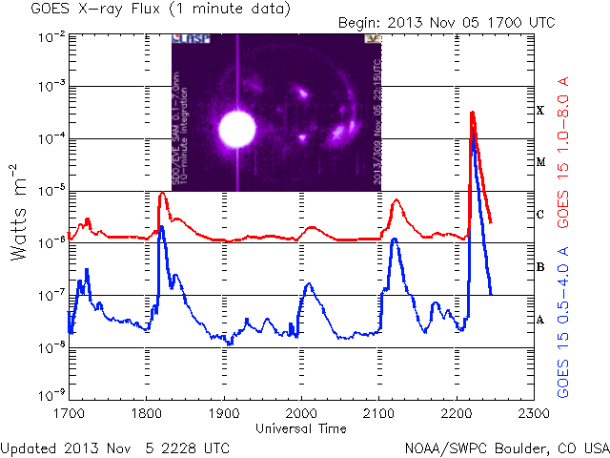
A Coronal Mass Ejection (CME) is visible in the LASCO C2 imagery and it is directed mostly towards the south and away from Earth.
This event produced R3 (Strong) Radio Blackout, as well as 10 cm Radio Burst and Type II and IV Radio Emission.
SUMMARY: 10cm Radio Burst
Begin Time: 2013 Nov 05 2212 UTC
Maximum Time: 2013 Nov 05 2212 UTC
End Time: 2013 Nov 05 2214 UTC
Duration: 2 minutes
Peak Flux: 400 sfu
Latest Penticton Noon Flux: 149 sfu
A 10cm radio burst indicates that the electromagnetic burst associated with a solar flare at the 10cm wavelength was double or greater than the initial 10cm radio background. This can be indicative of significant radio noise in association with a solar flare. This noise is generally short-lived but can cause interference for sensitive receivers including radar, GPS, and satellite communications.
ALERT: Type II Radio Emission
Begin Time: 2013 Nov 05 2216 UTC
Estimated Velocity: 1380 km/s
Type II emissions occur in association with eruptions on the sun and typically indicate a coronal mass ejection is associated with a flare event.
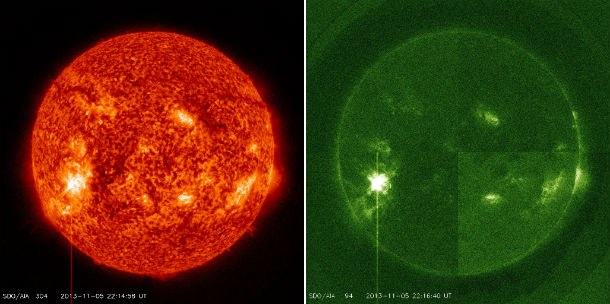
SDO's AIA 304 and AIA 094 images show moment of X3.3 flare eruption (Courtesy of NASA/SDO and the AIA, EVE, and HMI science teams)
Sunspot 1890 erupted an impulsive M2.5 flare earlier today, at 08:18 UTC . SOHO's LASCO C2 observed CME at 08:24 UTC UTC but the ejecta appeared heading to the south, away from Earth.
Sunspot 1890 has beta-gamma-delta class magnetic configuration and is capable of producing the strongest flares. This active region should be on the close lookout because it will soon rotate in the center of visible solar disk so any strong flares could launch plasma clouds toward our planet.
.jpg)
AIA 094, 335, 193 composite image (Courtesy of NASA/SDO and the AIA, EVE, and HMI science teams)
Currently, there are 6 numbered sunspots on the visible solar disk. Only Sunspot 1890 is beta-gamma-delta class. Sunspots 1884 and 1887 are beta-gamma class and still pose a threat. NOAA/SWPC forecasters estimate 45% chance of an M-class and 10% chance of an X-class solar flare in the next 24 hours.
.jpg)
Active sunspot regions on November 5, 2013. Image credit: NASA SDO/HMI. Edit: The Watchers
Update:
- AR 1890 erupted with moderate M3.8 solar flare at 13:46 UTC on November 6, 2013. The region is rotating into more geoeffective position. Earth directed eruptions from this region are possible in the days ahead.
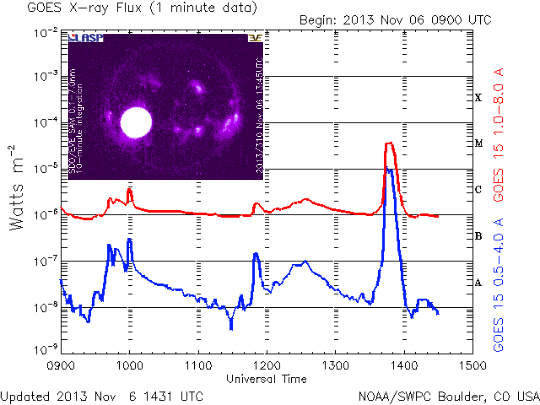
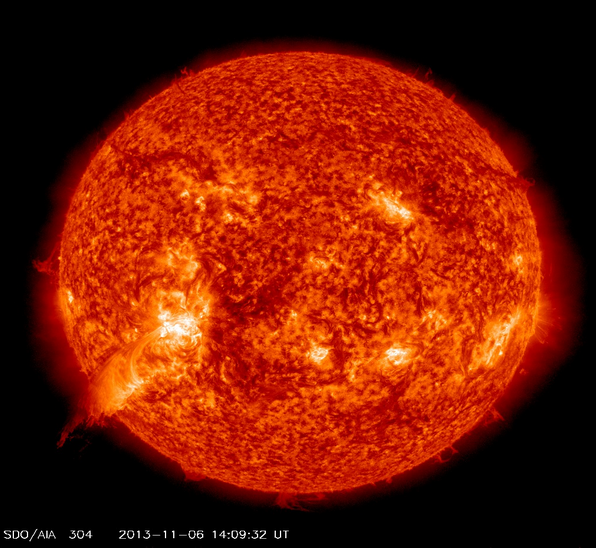
- Moderate eruption was registered off the southwest limb peaking as M1.8 solar flare at 00:02 UTC on November 7, 2013. This eruption might have partial Earth directed plasma cloud.
- At 03:40 UTC on November 7, AR 1890 produced another moderate M2.3 solar flare but it appears that associated CME is not Earth directed.
- AR 1891 located in the southern hemisphere continues to evolve and now possesses a Delta spot within the center of the group. There is a chance this region will produce more M-class solar flares
- At 14:25 UTC on November 7, AR 1890 erupted with yet another moderate solar flare peaking as M2.5. A Type II and IV Radio Emissions were observed as well as 10 cm Radio Burst:
ALERT: Type IV Radio Emission
Begin Time: 2013 Nov 07 1435 UTC
Description: Type IV emissions occur in association with major eruptions on the sun and are typically associated with strong coronal mass ejections and solar radiation storms.
***
ALERT: Type II Radio Emission
Begin Time: 2013 Nov 07 1417 UTC
Estimated Velocity: 633 km/s
Description: Type II emissions occur in association with eruptions on the sun and typically indicate a coronal mass ejection is associated with a flare event.
***
SUMMARY: 10cm Radio Burst
Begin Time: 2013 Nov 07 1418 UTC
Maximum Time: 2013 Nov 07 1419 UTC
End Time: 2013 Nov 07 1430 UTC
Duration: 12 minutes
Peak Flux: 170 sfu
Latest Penticton Noon Flux: 154 sfu
Description: A 10cm radio burst indicates that the electromagnetic burst associated with a solar flare at the 10cm wavelength was double or greater than the initial 10cm radio background. This can be indicative of significant radio noise in association with a solar flare. This noise is generally short-lived but can cause interference for sensitive receivers including radar, GPS, and satellite communications.
Featured image: AIA 304 (Courtesy of NASA/SDO and the AIA, EVE, and HMI science teams)

Commenting rules and guidelines
We value the thoughts and opinions of our readers and welcome healthy discussions on our website. In order to maintain a respectful and positive community, we ask that all commenters follow these rules:
We reserve the right to remove any comments that violate these rules. By commenting on our website, you agree to abide by these guidelines. Thank you for helping to create a positive and welcoming environment for all.